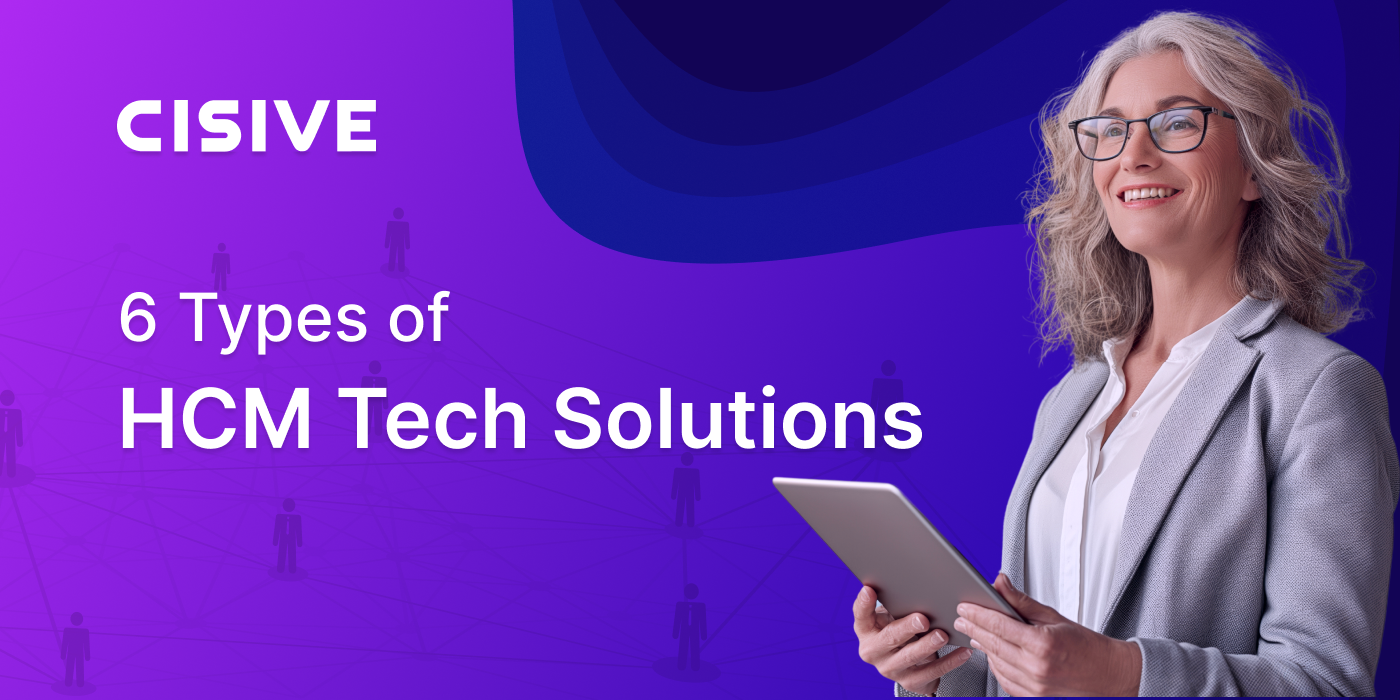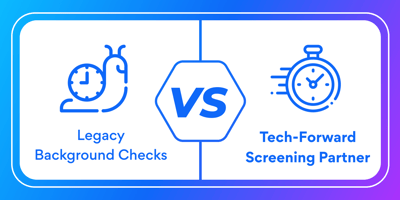

Did you know 49% of employers surveyed by Cisive cite turnaround time as their biggest background...

Ensuring you have the right people to fill key roles in your company is more complex than ever. Changing demographics, contract-based employees, compliance regulations, tightening labor markets, and remote positions all present new challenges. Any one of these can render your old operations obsolete.
You need a solution that engages your people and improves workforce productivity. It’s not that hard to find, if you know what to look for.
Human capital management (HCM) technology solutions assist your HR department in hiring, engaging, and retaining employees. Integrated solutions unify HR services by eliminating redundancies and synchronizing data, saving you time, money, and resources.
By transforming traditional HR functions into strategic opportunities, HCM optimizes performance and drives business success in a dynamic environment.
Key Takeaways:Here are the key things you need to know about human capital management technology solutions:
|
HCM technology solutions give you the power to manage and automate core HR functions across the employee lifecycle. From recruitment and onboarding to performance management and offboarding, these solutions create a more efficient workforce management process.
Modern HCM tech uses cloud-based technology to process data, generate reports, and create smooth user experiences. They include tools like applicant tracking systems, performance management modules, and learning management systems. Integrated platforms stimulate productivity and engagement while providing insights for your HR team.
HCM technology solutions offer numerous benefits. They eliminate redundancies, synchronize data, and improve efficiency. If you centralize employee information and automate routine tasks, you’ll have more time to focus on other aspects of your job.
They also empower employees through self-service portals and mobile access, which improves the overall employee experience.
HCM technologies involve a wide range of applications to manage your workforce. You'll find solutions for:
HCM systems require you to input all types of information. You'll need to submit employee data, such as personal details, job roles, and performance metrics. The systems also rely on you providing company information such as company structure, policies, and job descriptions. Regularly update this information to ensure that the system is accurate and relevant.
Cloud-based systems require less maintenance because the provider handles updates and security. If your platform is on-site, however, it may demand more attention from your IT team. You'll perform regular data backups, system updates, and security checks. You should also train your staff to properly use the system and stay informed about new features and best practices.
Regardless of your industry or HR management structure, there is an HCM tech solution for you. Below are some of the more well-known solutions that improve your processes and help you manage your workforce more effectively.
ATS software streamlines your recruitment and screening process. You can manage job postings, track applicants, and collaborate with hiring managers all in one place.
Systems include features like résumé parsing and candidate scoring. You'll find it easier to identify top talent and move them through your hiring pipeline efficiently.
Performance management tools help you track and evaluate employee performance. You can set goals, conduct reviews, and provide continuous feedback to your team.
Helpful tools include 360-degree feedback and performance analytics. You'll gain valuable insights into your workforce's strengths and areas for improvement.
With LMS platforms, you can create and manage employee training programs when onboarding a new employee. You can create courses, track progress, and assess learning outcomes.
Systems come with content libraries and mobile learning options designed to enrich your staff. A high-quality LMS enables you to provide your employees with flexible, on-demand learning opportunities.
Automate your payroll and compensation process with payroll and benefits software. You can manage salaries, taxes, and benefits more accurately all in one system.
These solutions include features for time tracking and compliance management. You'll reduce errors and ensure that your organization meets all legal requirements.
Self-service portals let employees manage their own employment profiles. They can update personal details, request time off, and obtain important documents without going through a complicated process.
Mobile apps give your entire team on-the-go access so they can provide and receive quick updates as needed. These types of solutions improve employee satisfaction and reduce the administrative burden on your HR team.
Workforce analytics tools help you make data-driven decisions when managing your workforce. They can provide critical information on your turnover rates, employee engagement, skill gaps, attendance, and more. With this data, you can analyze trends, predict future needs, and measure the impact of your hiring and retention strategies.
Systems include customizable dashboards and reporting features. You gain valuable insights that improve your overall workforce strategy and create a smoother HR process.
HCM technology solutions are valuable tools and resources in medium to enterprise-level companies that need to manage a sizable workforce. Larger organizations have complex HR processes, multiple departments, and an employee base scattered in numerous locations.
Companies with 500 or more employees find HCM systems helpful due to the scale and complexity of their human resource management needs.
Industries that heavily rely on HCM technology solutions include:
These sectors often have large, diverse workforces and face unique challenges in talent management, compliance, and employee engagement.
However, enterprise-level companies are not the only organizations that use HCM tech. Small and medium-sized businesses (SMBs) may also adopt HCM technologies with more streamlined or simpler solutions. As your company grows and your HR needs become more complex, you can expand your HCM systems and automate your processes as needed.
HCM technology is vital for modern businesses because it drives strategic workforce management. It helps you create a workable game plan for employee onboarding, management, and offboarding.
HCM solutions offer benefits such as improved talent acquisition, employee engagement, and more accurate workforce planning. The result is increased productivity, leading to increased business success.
HCM solutions create a more engaging and supportive work environment. They offer tools for continuous feedback, performance management, and career development planning. These opportunities help employees feel valued and more invested in their roles.
On a day-to-day basis, HCM solutions empower employees to manage their own information, request time off, and access important documents. This autonomy and transparency contribute to higher job satisfaction and a sense of control over their work lives.
Example: A large retail company implements an HCM system with career development planning. Employees could state their goals, access personalized training programs, and track their progress. Within the first year, the company sees a 20% decrease in turnover rates as employees feel more supported in their professional growth.
HCM solutions promote professional growth by offering learning management systems (LMS) and personalized training programs. They allow your company to create and track employee training goals efficiently.
With the power of AI, HCM systems can suggest relevant courses or learning paths based on an employee's role, skills gap, or career interests. This targeted approach helps your employees receive the most beneficial training for their professional development.
Example: A technology company uses its HCM system to identify skill gaps in its workforce. The system recommends online courses and workshops to address these gaps. Within six months, the company sees a 30% increase in employees with critical technical skills. The company benefits from faster project delivery times and higher customer satisfaction.
HCM solutions provide analytics and data that help you make smarter decisions. They collect and analyze vast amounts of workforce data to offer insights into trends and potential issues.
With predictive analytics, the technology can forecast future workforce needs, as well as identify flight risks and suggest proactive measures to address problems. This data-centric approach allows your HR team to move from reactive to strategic decision-making.
Example: A manufacturing company uses its HCM system's analytics to identify a correlation between employee engagement scores and productivity levels. Based on this insight, they implement targeted engagement initiatives. The result is a 15% increase in overall productivity within a quarter.
HCM solutions centralize HR operations by providing a single, integrated platform for all HR-related tasks and information. Centralization eliminates the need for multiple disconnected systems. It reduces inconsistencies and improves efficiency.
With a centralized HCM system, you can access all employee information in one place. It saves time and reduces errors. Plus, it ensures compliance with data protection regulations.
Example: A company implements a cloud-based HCM solution to unify its HR operations across 20 countries. The centralized system standardizes all HR processes and improves data accuracy. It also reduces administrative costs by 25% within the first year of implementation.
While HCM technology solutions offer benefits, you’ll face a few challenges when implementing and using these systems. Issues range from technical issues to cultural resistance and a significant learning curve.
Knowing hurdles in advance can help your business mitigate potential problems. Here are six common challenges associated with HCM technology:
To implement HCM technology solutions in your organization, start by conducting a company needs assessment.
Identify your current HR pain points, issues, and goals. Involve key people from various departments to gather input on their specific needs and requirements. This initial step will help you select an HCM solution that aligns with your company's objectives.
Once you've chosen a system, you’ll need to develop a comprehensive implementation plan. Create a timeline with milestones, and assign responsibilities to team members. Consider forming a dedicated project team with representatives from HR, IT, and relevant areas of your organization to design and lead the implementation.
Next, develop a comprehensive training program for HR staff, managers, and employees. Offer a mix of in-person sessions, online tutorials, and user guides. Focus on both the technical aspects of the new system and the benefits it brings.
Finally, plan for a phased rollout to minimize disruption and allow for adjustments. Start with a pilot group or a single department before expanding to the entire organization. Monitor KPIs closely during the initial stages to measure its impact. Gather feedback from users and make necessary changes.
HCM technology solutions from Cisive give you the leverage you need to run your HR department efficiently. Our tools help you streamline your processes, engage more people, and create a system that keeps your workforce running smoothly. Start a demo of your desired tool or book a consultation with an HCM specialist to get started today.

Did you know 49% of employers surveyed by Cisive cite turnaround time as their biggest background...

As talent markets evolve and compliance risks grow, background screening is no longer a simple step...

The healthcare industry faces a talent crisis of unprecedented scale. With aging populations...